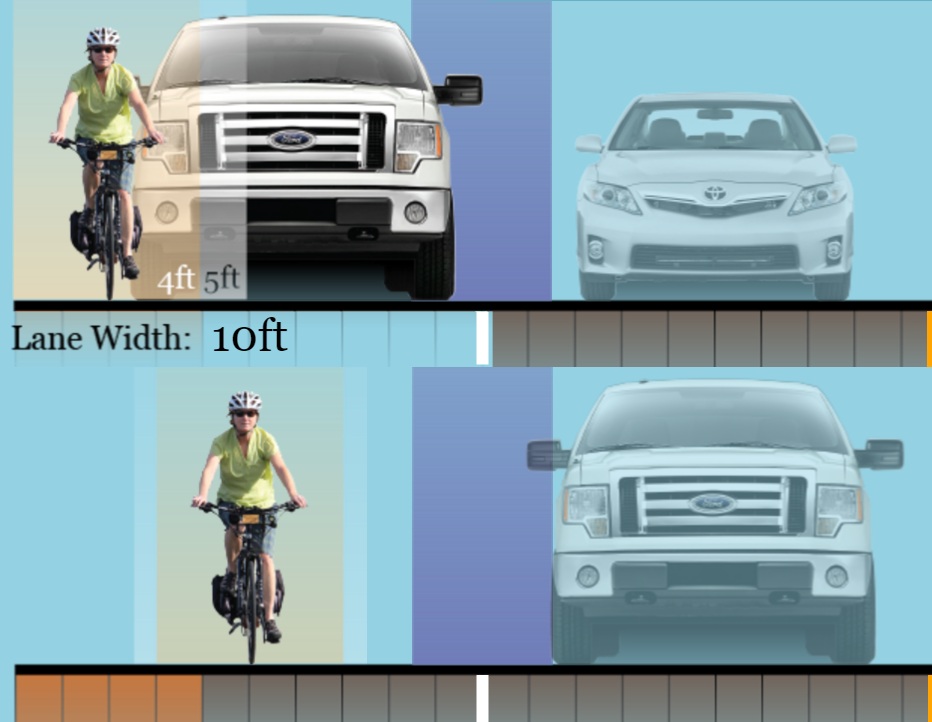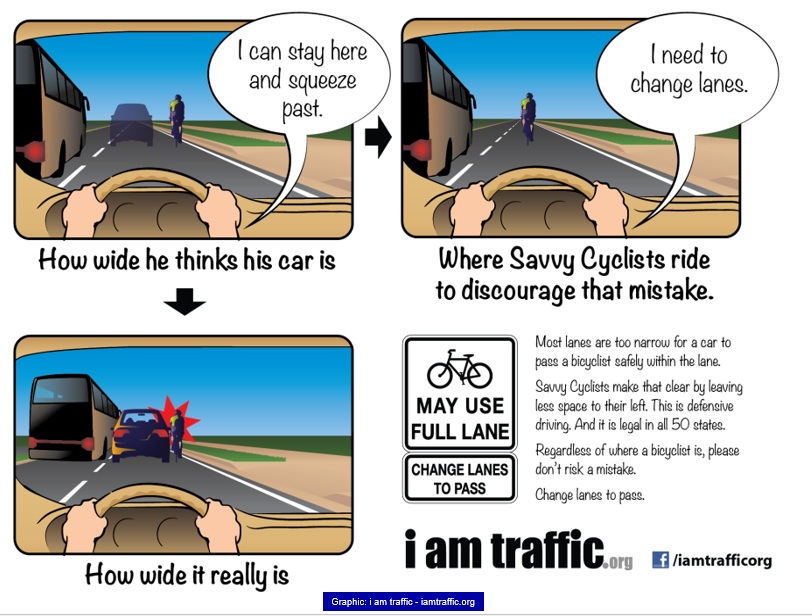This post is reproduced with permission from a page on the Bike Walk NC website, with some edits to reflect PA motor vehicle code. The author is Steven Goodridge. Links to full articles on their organization's website have been retained as useful references. The relevant portions of the PA laws have been inserted, replacing their citations of NC law. And it should be noted that the PA safe passing law calls for drivers to leave 4 feet clear when passing cyclists. The required clearance in both NC and TX (referenced in a video embedded below) is only 3 feet. Readers/viewers are asked to keep that in mind. The full original post can be found here.
Motor vehicle drivers pass bicyclists safely countless times every day. When done improperly, however, the results can be tragic. Some drivers say that they are unsure of what to do when they encounter bicyclists on the road ahead. It’s therefore important to increase public awareness of how to pass a bicyclist safely.

Safe passing of a bicyclist on ordinary roads requires following three simple steps:
- Slow Down.
- Look and Wait until Safe.
- Change Lanes to Pass.
Let’s look at each step in detail:
1. Slow Down
Your first responsibility as a driver is to not hit other people who are already in front of you. This means always being prepared to match their speed or stop as required. Slowing down ensures that you’ll have the time you need to fully assess the road and traffic conditions prior to executing a safe pass. Lower speed also gives you more time to react should conditions change, and greatly reduces the danger you pose to the bicyclist should a collision occur.
If you’re traveling too fast to slow down in time, that means you’re violating the basic speed law. You must always limit your speed so that you can stop within the distance that you can see ahead. This principle is known as assured clear distance ahead. Always choose a safe speed for conditions, and keep your eyes on the road.
Don’t pass bicyclists at high speed; high speed is associated with most sideswipe collisions involving motorists passing bicyclists. Slower speed gives everyone on the road more time to see, think, and respond to one another.
2. Look and Wait until Safe
Don’t try to squeeze between a bicyclist and other traffic in the adjacent lane. On the vast majority of roads, travel lanes aren’t wide enough for this to be safe. Attempting to squeeze past a bicyclist in the same lane is the most common cause of car-overtaking-bicycle collisions. You’ll need space in the next lane in order to pass, so look for a safe gap in that traffic and wait as required. If the adjacent lane is for opposite-direction traffic, wait until you have sufficient sight distance to ensure that no traffic will arrive before you can complete the pass.
Some bicyclists will hug the right edge of a narrow travel lane in an effort to stay as far away from other traffic as they can manage. Don’t misinterpret this as an invitation to pass within the same narrow lane; these bicyclists report lots of unsafe same-lane passing of the type that most often results in collisions. Knowledgeable bicyclists will often ride near the center of a narrow lane, or ride two abreast, in order to deter motorists from making the mistake of trying to squeeze by. These cyclists aren’t being rude; they are just driving defensively.
Make sure you can see an adequate distance ahead to ensure oncoming traffic won’t arrive before you finish your pass. State law requires waiting until you have adequate clear sight distance before you pass. The longer the group of cyclists, the greater distance you’ll need.
§ 3305. Limitations on overtaking on the left.
No vehicle shall be driven to the left side of the center or marked center line of the roadway in overtaking and passing another vehicle proceeding in the same direction unless the left side is clearly visible and is free of oncoming traffic for a sufficient distance ahead to permit the overtaking and passing to be completely made without interfering with the operation of any vehicle approaching from the opposite direction or any vehicle overtaken.
§ 3306. Limitations on driving on left side of roadway.
(a) General rule.--No vehicle shall be driven on the left side of the roadway under any of the following conditions:
(1) When approaching or upon the crest of a grade or a curve in the highway where the driver's view is obstructed within such distance as to create a hazard in the event another vehicle might approach from the opposite direction.
(2) When approaching within 100 feet of or traversing any intersection or railroad grade crossing, unless otherwise indicated by official traffic-control devices.
Lastly, don’t attempt to pass a bicyclist immediately before turning right. You may underestimate the bicyclist’s speed and cut the bicyclist off or hit them during your turn. Instead, slow down and merge to the right behind the bicyclist as you approach the turn. It’s better to follow for a few extra seconds than to risk a collision.
3. Change Lanes to Pass
Once you have an adequate gap in traffic in the next lane, move completely into that lane. This will give the bicyclist a safe buffer and the room they need to maneuver for maintaining balance and avoiding surface hazards.
You may ask: “What if there is a solid line indicating a no passing zone?” Passing a bicyclist in a no-passing zone is legal in Pennsylvania when done safely with no oncoming traffic and adequate sight distance, passing at a distance of at least four feet or moving completely into the next lane. See Section 3307 b.1.
You may ask: “What if I start to pass and I realize that I’ve misjudged oncoming traffic?” Simple: Press your brake pedal, and slip back behind the bicyclist(s). No harm, no foul. Worst case: Stop completely, and let everybody sort it out. Stopped vehicles don’t hurt people.
Here’s a video from the Austin, Texas, Police Department that discusses safe passing:
These three steps don’t take much time and effort. In many cases there is no net delay to the motorist; in the worst cases, the delay is rarely longer than that of waiting for a traffic signal. If you experience delays that are longer in North Carolina, we’d like to know about it, so we can better understand the effects of road design and bicycle traffic on your convenience, and consequently support desirable road improvements and/or have an informed discussion about where and when bicyclists may be able to help you pass sooner. Send email to contact@bikewalknc.org to send us the North Carolina road location, time and date of where you first encountered a long delay, and where on the road the delay ended, and we’ll share your information with NCDOT as well.
For more information about safe passing, see the following:
- Safe Passing Principles, Laws, and Recommendations by BikeWalk NC
- Recommendation to allow passing bicycles on North Carolina Highways by Kevin Lacy, State Traffic Engineer, NCDOT (also here)
- Safe Passing and Solid Centerlines by BikeWalk NC
- Crossing a Double Yellow Line by Eli Damon, I Am Traffic
- Sharing the Road, North Carolina Driver Handbook, Chapter 6, pages 81-82
Here are some memes that may come in handy. Feel free to deploy them on social media.




